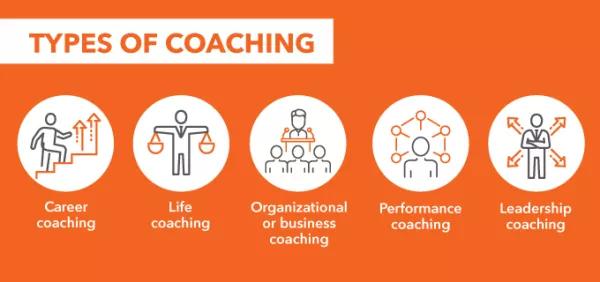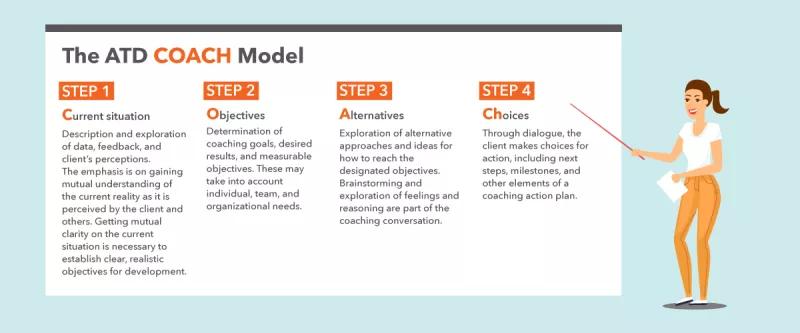What is Executive Coaching?
To understand what an executive coach is, we first must take a look at the definition of coaching. According to the International Coach Federation (ICF), coaching is defined as a partnership with clients in a thought-provoking and creative process that inspires them to maximize their personal and professional potential. Coaching is a client-driven process that’s distinct from other service professions, such as counseling, mentoring, consulting and training.
While the ATD COACH model continues to be a wide-received and accepted model for coaching, many coaches have been using the GROW model since the 1980s in corporate settings. GROW stands for goal, current reality, options (or obstacles), and will (or way forward). There are other models for coaching as well, including FUEL; SOAR; Fierce Conversations; and Purpose, Perspectives, Process.All the models have similar elements in discovering the client’s perspective and reality, setting goals or objectives, offering differing points of views or options, and then choosing the best course of action to move ahead toward a desired state.This is rooted in a relationship built upon trust and ensuring the client’s privacy while maintaining confidentiality.
Types of Coaching
Executive coaches are not the only types of coaches in the professional world. Many managers now take classes to develop their own coaching skills so they can help their employees improve their performance, obtain promotions, and develop into leadership roles. Both internal and external coaches can be found offering different levels of support:

Career coaching—Provides support for employees looking to make a career transition, whether short or long term, including guidance on their professional development and job search. Career coaches may help with resume writing, job searches, online profiles, and job interviewing. Life coaching—While not the most popular type of coaching within an organization, life coaches are still sometimes present internally. This specialty of coaching focuses on a variety of aspects of life, including career, health and fitness, finances, relationships, and spiritual growth. Organizational or business coaching—Provides business owners and entrepreneurs with support in identifying goals, creating strategies to obtain those goals, and boosting the overall performance of the organization. Performance coaching—Supports those within organizations who need to improve their work performance, often as a result of performance appraisal results, regardless of level or job title. Leadership coaching—Provides coaching for those looking to grow and develop leadership skills, regardless of whether they are an individual contributor, manager, or senior manager.
The ATD Coach Model

The GROW Model
While the ATD COACH model continues to be a wide-received and accepted model for coaching, many coaches have been using the GROW model since the 1980s in corporate settings. GROW stands for goal, current reality, options (or obstacles), and will (or way forward). There are other models for coaching as well, including FUEL; SOAR; Fierce Conversations; and Purpose, Perspectives, Process.
All the models have similar elements in discovering the client’s perspective and reality, setting goals or objectives, offering differing points of views or options, and then choosing the best course of action to move ahead toward a desired state.This is rooted in a relationship built upon trust and ensuring the client’s privacy while maintaining confidentiality.
What Coaching Is Not
A lot of people confuse coaching with counseling or mentoring. Coaching is different from these practices in several ways. Coaching does not offer therapeutic outcomes like counseling. Merriam-Webster defines counseling as “professional guidance of the individual by utilizing psychological methods, especially in collecting case history data, using various techniques of the personal interview, and testing interests and aptitudes.” While counseling does offer a hefty amount of introspection, it also spends a lot of time looking toward one’s past, whereas coaching is future-oriented. Mentoring is a self-directed, mutually beneficial, long-term relationship between two individuals for long-term career movement where the mentor does most of the talking and offers advice. While coaching is a true partnership among equals, mentoring most typically consists of a more experienced person directly guiding the mentee through an experience that the mentor has already been through. Coaching, on the other hand, is a conversation focused on helping other people (coachees or clients) move forward relative to their goals, hopes, and curiosities—not to dig into their past. For coaching to be helpful, it should be directly tied to what the client wants to accomplish, through a process that is directed by the coachee, where the coachee is empowered to uncover and develop their own path to achieving their goal and does the majority of the talking. Because coaches are dealing with such personal and sensitive information, they should abide by ethical guidelines. Some professional organizations, such as ATD and ICF, have developed such guidelines and codes of conduct that apply to the practice of coaching. Included in those guidelines are honesty, fairness, lawfulness, compassion, respect, loyalty, and dependability.
How Can ATD Help?
ATD has long understood the need for coaching in the workforce. We know coaching provides a powerful development tool that leads to positive change and results in one’s performance, career, and the organization as a whole. That is why ATD curates the best content from some of the most experienced coaches across the country to develop coaching content and offerings. Talent development professionals and managers alike look to ATD to help them improve their ability to develop internal coaching programs, learn about coaching practices and competencies, and gain successful strategies to amplify coaching abilities. For access to even more resources, including practical tools and templates, research, and insights, you’re invited to become an ATD member. Learn more. For more ATD resources about executive coaching, visit the following:

BLOGS
Coaching Topic Page
Explore coaching articles for all levels. Find strategies, insights, and best practices to elevate your expertise. Start here!

NEWSLETTER
OD & Talent Management Newsletter
Insights and trends for improving an oganization's capability. Sign up today!

COURSES BY ROLE
Coaches
Check out our recommended certificate programs for coaches, including core, specialist, and advanced programs. Learn more!

EVENTS
ATD Events
Talent development professionals come together to give you conference experiences that are diverse in education, solutions, and opportunities. Learn more!

GLOSSARY TERMS
Talent Development Glossary Terms
Learn about essential terms and need-to-know expressions for training and development professionals. Explore now!
Free E-Book: What Is Executive Coaching?
Discover what an executive coach is, the requirements and skillsets needed to be a good executive coach, and a template of the overview of the coaching process.
